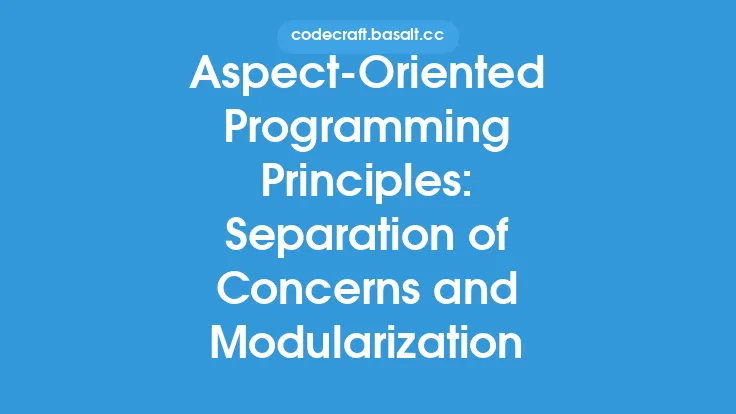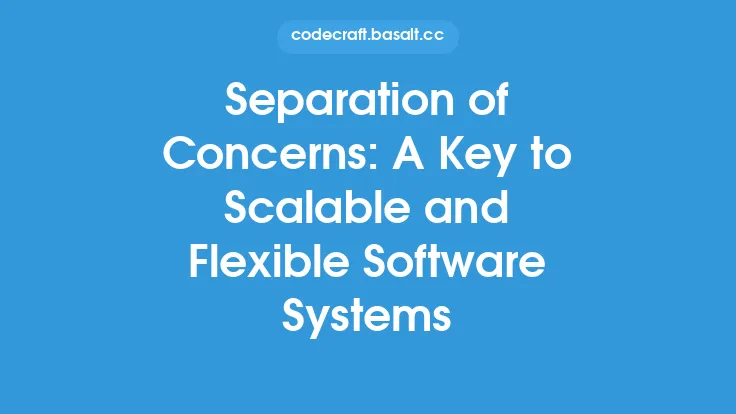Object-oriented design is a fundamental concept in programming paradigms, and two of its core principles are separation of concerns and single responsibility. These principles are essential for creating maintainable, scalable, and efficient software systems. In this article, we will delve into the details of these principles, exploring their definitions, benefits, and applications in object-oriented programming.
Introduction to Separation of Concerns
Separation of concerns is a design principle that involves dividing a software system into distinct components, each responsible for a specific aspect of the system's functionality. This principle is based on the idea that a system should be composed of independent modules, each addressing a particular concern or feature. By separating concerns, developers can create systems that are more modular, flexible, and easier to maintain. Separation of concerns is not unique to object-oriented programming, but it is a fundamental principle that is widely applied in OOP.
Single Responsibility Principle
The single responsibility principle (SRP) is a design principle that states that a class should have only one reason to change. In other words, a class should have a single responsibility or purpose, and any changes made to the class should be related to that responsibility. This principle is closely related to separation of concerns, as it emphasizes the importance of dividing a system into distinct components, each with a specific responsibility. The SRP is essential for creating classes that are cohesive, maintainable, and easy to understand.
Benefits of Separation of Concerns and Single Responsibility
The separation of concerns and single responsibility principles offer several benefits, including improved maintainability, scalability, and reusability. By dividing a system into distinct components, each with a specific responsibility, developers can make changes to the system without affecting other components. This reduces the risk of introducing bugs or causing unintended side effects. Additionally, separation of concerns and single responsibility make it easier to test and debug software systems, as each component can be tested independently.
Application of Separation of Concerns and Single Responsibility in OOP
In object-oriented programming, separation of concerns and single responsibility are applied through the use of classes, interfaces, and other design elements. For example, a class might be responsible for data storage, while another class handles data processing. By separating these concerns, developers can create systems that are more modular and easier to maintain. The single responsibility principle is also applied through the use of classes, where each class has a single responsibility or purpose.
Best Practices for Implementing Separation of Concerns and Single Responsibility
To implement separation of concerns and single responsibility effectively, developers should follow several best practices. First, they should identify the distinct concerns or features of a system and divide them into separate components. Second, they should ensure that each component has a single responsibility or purpose. Third, they should use design elements such as classes, interfaces, and inheritance to implement separation of concerns and single responsibility. Finally, they should continuously refactor and improve their design to ensure that it remains maintainable, scalable, and efficient.
Common Pitfalls and Challenges
While separation of concerns and single responsibility are essential principles in object-oriented design, there are several common pitfalls and challenges that developers may encounter. One of the most significant challenges is identifying the distinct concerns or features of a system and dividing them into separate components. This requires a deep understanding of the system's requirements and functionality. Another challenge is ensuring that each component has a single responsibility or purpose, as this requires careful design and planning. Additionally, developers may encounter challenges when implementing separation of concerns and single responsibility in legacy systems or systems with complex dependencies.
Conclusion
In conclusion, separation of concerns and single responsibility are fundamental principles in object-oriented design that are essential for creating maintainable, scalable, and efficient software systems. By dividing a system into distinct components, each with a specific responsibility, developers can create systems that are more modular, flexible, and easier to maintain. The single responsibility principle is closely related to separation of concerns, as it emphasizes the importance of dividing a system into distinct components, each with a specific responsibility. By following best practices and avoiding common pitfalls and challenges, developers can effectively implement separation of concerns and single responsibility in their software systems, leading to improved maintainability, scalability, and reusability.





